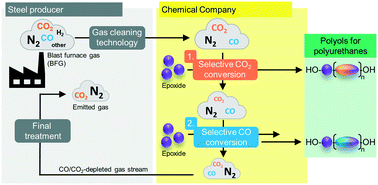Turning CO/CO2-containing industrial process gas into valuable building blocks for the polyurethane industry†
Abstract
Transforming the chemical industry from finite fossil to renewable carbon resources displays one of the major challenges of the 21st century. At the same time the steel industry needs to reduce the CO2 emissions of the blast furnaces to decrease its environmental impact. Turning this lose–lose into a win–win situation is the basic concept of the EU-funded Carbon4PUR project and the essence of this contribution. Provided is a first concept of how the carbon content of blast furnace gas (BFG), a CO/CO2-containing process gas from steel production, could be utilized in a sequence of selective chemical conversion steps to produce high value intermediates for the polymer industry. The chemical process utilizing this mixed gas stream is built up by a mixture of emerging chemical technologies starting with the catalytic conversion of CO2 with propylene oxide to produce polyether-carbonate polyols along with a CO2-depleted gas stream. Selective CO conversion is tackled in the second process step by a catalytic ring-expansion carbonylation of epoxides to cyclic anhydride structures. These diacid equivalents can be utilized for the synthesis of polyether ester polyols, an essential component for the formation of rigid construction foams. This work shows a first proof of concept of the individual chemical conversion steps of the Carbon4PUR process from lab to technical scale with a particular focus on the final industrial applicability.



 Please wait while we load your content...
Please wait while we load your content...